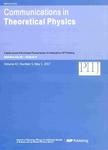One Electron Atom in Special Relativity with de Sitter Space-Time Symmetry
One Electron Atom in Special Relativity with de Sitter Space-Time Symmetry作者机构:Interdisciplinary Center for Theoretical StudyDepartment of Modern PhysicsUniversity of Science and Technology of China
出 版 物:《Communications in Theoretical Physics》 (理论物理通讯(英文版))
年 卷 期:2012年第57卷第6期
页 面:930-952页
核心收录:
学科分类:07[理学] 070203[理学-原子与分子物理] 070201[理学-理论物理] 0702[理学-物理学]
基 金:Supported in part by National Natural Science Foundation of China under Grant No. 10975128 by the Chinese Science Academy Foundation under Grant No. KJCX-YW-N29
主 题:hydrogen atom special relativity with de sitter space-time symmetry time variation of physical constants Lamb shift time dependent Hamiltonian in quantum mechanics Friedmann-Robertson-Walker (FRW) universe
摘 要:The de Sitter invariant Special Relativity (dS-SR) is SR with constant curvature, and a natural extension of usual Einstein SR (E-SR). In this paper, we solve the dS-SR Dirac equation of Hydrogen by means of the adiabatic approach and the quasi-stationary perturbation calculations of QM. Hydrogen atom is located in the light cone of the Universe. FRW metric and ACDM cosmological model are used to discuss this issue. To the atom, effects of de Sitter space-time geometry described by Beltrami metric are taken into account. The dS-SR Dirac equation turns out to be a time dependent quantum Hamiltonian system. We reveal that: (i) The fundamental physics constants me, h, e variate adiabatically along with cosmologic time in dS-SR QM framework. But the fine-structure constant α≡ - e^2/(hc) keeps to be invariant; (ii) (2s^1/2 - 2p^1/2)-splitting due to dS-SR QM effects: By means of perturbation theory, that splitting △E(z) are calculated analytically, which belongs to O(1/R^2)-physics of dS-SR QM. Numerically, we find that when |R| = {103 Gly, 104 Gly, 105 Gly}, and z = {1, or 2}, the AE(z) 〉〉 1 (Lamb shift). This indicates that for these cases the hyperfine structure effects due to QED could be ignored, and the dS-SR fine structure effects are dominant. This effect could be used to determine the universal constant R in dS-SR, and be thought as a new physics beyond E-SR.



